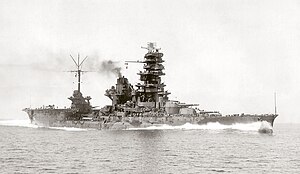Japanese battleship Hyūga

Hyūga after her 1943 conversion to a battleship/aircraft carrier.
|
|
| History | |
|---|---|
|
|
|
| Name: | Hyūga |
| Namesake: | Hyūga Province |
| Ordered: | 1912 |
| Builder: | Mitsubishi |
| Laid down: | 16 May 1915 |
| Launched: | 27 January 1917 |
| Commissioned: | 30 April 1918 |
| Struck: | 20 November 1945 |
| Fate: |
|
| General characteristics | |
| Class and type: | Ise-class battleship |
| Displacement: | 38,872 long tons (39,496 t) |
| Length: | 219.62 m (720 ft 6 in) |
| Beam: | 33.8 m (110 ft 11 in) |
| Draft: | 9.14 m (30 ft 0 in) |
| Installed power: | 33,556.5 kW (45,000 shp) |
| Propulsion: |
|
| Speed: |
|
| Capacity: | |
| Complement: | 1,463 |
| Armament: |
|
| Armour: |
|
| Aircraft carried: | 3 × floatplanes |
| Aviation facilities: | 1 × catapult |
Hyūga (日向), named for Hyūga Province in Kyūshū, was an Ise-class battleship of the Imperial Japanese Navy (IJN) laid down by Mitsubishi on 6 May 1915, launched on 27 January 1917 and completed on 30 April 1918. She was initially designed as the fourth ship of the Fusō-class, but was heavily redesigned to fix shortcomings. Hyūga was extensively updated and reconstructed from 1926–28 and 1934–36.
At the outbreak of the Pacific war, Hyūga was part of the battleship force at the Combined Fleet's anchorage at Hashirajima. On 7 December she sortied for the Bonin Islands, (known in Japan as the Ogasawara Group), along with her sister ship Ise of Battle Division 3 and with Nagato and Mutsu of Battle Division 1 as part of the reserve battle fleet for Operation Z (the attack on Pearl Harbor). The force returned to the Combined Fleet's anchorage at Hashirajima on 12 December 1941 and remained there until a 4 March raid against the Japanese base on Marcus Island (Minami Tori Shima), 1,200 miles (1,900 km) off the coast of Japan. The raid, commanded by Vice Admiral Halsey and Task Force 16 caused the IJN to sortie out in search of the American raiders. Halsey had steamed away at high speed once he recovered his aircraft and the Japanese were unable to make contact. April saw Halsey return, this time steaming within 650 miles (1,050 km) of the Japanese home islands along with the aircraft carrier Hornet of Task Force 18 to launch the Doolittle Raid. Once again Hyūga and the elements of the Combined Fleet sortied in chase, but Halsey and his group slipped away before the IJN could engage him.
...
Wikipedia
